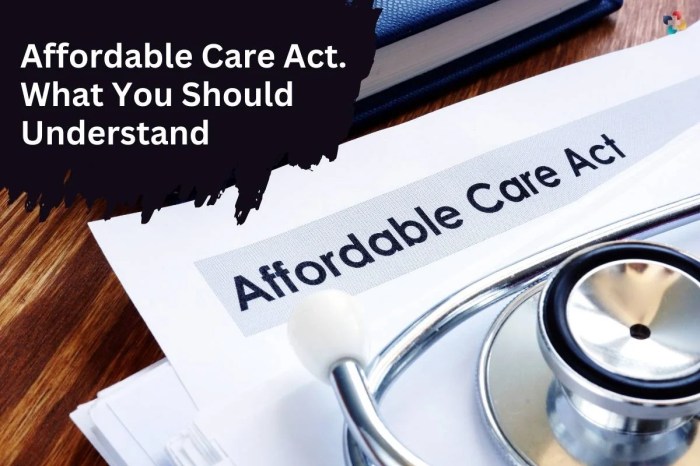Affordable Health Insurance Plans Made Simple
Affordable Health Insurance Plans sets the stage for navigating the often complex world of healthcare coverage. In today’s fast-paced environment, understanding the nuances of these plans is essential for individuals and families seeking quality medical care without breaking the bank. From defining what makes a plan affordable to exploring the various types available, this guide aims to simplify the choices in health insurance, making it easier for you to find coverage that fits your needs and budget.
With the rising costs of healthcare, the demand for affordable health insurance has never been more critical. This overview will delve into key features, eligibility criteria, and actionable tips for finding the best insurance options available. Whether you’re a first-time buyer or looking to switch plans, we’ll provide you with the insights you need to make informed decisions.
Understanding Affordable Health Insurance Plans
Affordable health insurance plans are designed to make healthcare accessible to individuals and families without overwhelming financial burdens. These plans aim to provide essential health coverage while ensuring that premiums remain manageable. It’s essential to grasp the features and factors that influence the affordability of these insurance options.Affordable health insurance plans typically encompass a range of essential health benefits and cost-sharing mechanisms.
They are structured to balance affordability with adequate coverage, which is crucial for promoting overall health and well-being among consumers. Key features often include low premiums, out-of-pocket maximums, and comprehensive coverage for preventive care, hospitalization, and prescription medications.
Key Features of Affordable Health Insurance Plans
Understanding the key features that characterize affordable health insurance plans can help consumers make informed decisions. These features ensure that individuals receive necessary healthcare services while managing their financial responsibilities. The primary attributes include:
- Low Premiums: Affordable plans are designed to keep monthly payments low, making health insurance accessible for various income levels.
- Preventive Services: Many plans cover preventive services without any cost-sharing, encouraging individuals to seek early treatment and reduce long-term healthcare costs.
- Cost-Sharing Options: These plans typically include deductibles, copayments, and coinsurance that are structured to remain manageable, ensuring that individuals can afford necessary care.
- Out-of-Pocket Maximums: Affordable health insurance plans often cap the amount consumers spend on covered services in a year, providing financial protection against high medical costs.
- Comprehensive Coverage: These plans usually cover a wide range of services, such as hospitalization, outpatient care, and prescription drugs, fulfilling essential healthcare needs.
Factors Influencing Health Insurance Premiums
Several factors play a significant role in determining the cost of health insurance premiums. Understanding these can help individuals anticipate their potential expenses and choose a plan that fits their budget. Key influences on premium costs include:
- Age: Generally, older individuals may face higher premiums due to increased healthcare needs and risks associated with aging.
- Location: Insurance costs can vary significantly based on geographic location, influenced by regional healthcare costs and regulations.
- Health Status: Personal health history and pre-existing conditions can impact premium rates, as individuals with more health issues typically incur higher costs.
- Plan Type: Different types of insurance plans, such as HMOs, PPOs, and EPOs, offer varying degrees of flexibility and coverage, influencing overall costs.
- Income Level: Lower-income individuals may qualify for premium subsidies, reducing their costs and making health insurance more affordable.
Affordable health insurance plans are essential for ensuring access to necessary healthcare services without placing undue financial strain on individuals and families.
Types of Affordable Health Insurance Plans
Affordable health insurance plans come in various forms, each designed to cater to different needs, preferences, and financial situations. Understanding these types can help individuals and families make informed decisions about their healthcare coverage. The market offers several options, including Health Maintenance Organizations (HMOs), Preferred Provider Organizations (PPOs), Exclusive Provider Organizations (EPOs), and Point of Service (POS) plans. Each of these plans has unique benefits and considerations that can significantly affect healthcare access and out-of-pocket costs.
Types of Plans Available
When selecting a health insurance plan, it’s crucial to consider the types available and how they align with your healthcare needs and budget. Here’s a breakdown of the most common affordable health insurance plans:
- Health Maintenance Organization (HMO): HMOs require members to choose a primary care physician (PCP) and get referrals to see specialists. While they usually offer lower premiums and out-of-pocket costs, they have a limited network of providers.
- Preferred Provider Organization (PPO): PPOs offer greater flexibility by allowing members to see any healthcare provider, but they save money by using a network of preferred providers. No referrals are necessary, but out-of-network services may come with higher costs.
- Exclusive Provider Organization (EPO): EPOs combine features of HMOs and PPOs. They do not require referrals, and while they provide some flexibility, they do not cover out-of-network services except in emergencies. This plan is generally more affordable than a PPO.
- Point of Service (POS): POS plans require members to choose a primary care physician and get referrals but also allow out-of-network visits at a higher cost. They can provide a balance of flexibility and cost-effectiveness.
Comparison of Plan Benefits
Understanding the benefits of each type of health insurance plan helps in evaluating which may be the most suitable option. Here’s a comparative look at HMO, PPO, EPO, and POS plans regarding their key benefits:
| Plan Type | Network Restrictions | Referral Requirements | Cost |
|---|---|---|---|
| HMO | Limited to network providers | Required for specialists | Lower premiums and copayments |
| PPO | More extensive network, out-of-network available | No referrals necessary | Higher premiums, lower out-of-pocket for network |
| EPO | Limited to network providers | No referrals needed | Typically lower than PPO, no out-of-network coverage |
| POS | Limited to network, but out-of-network allowed | Referrals required | Moderate premiums, higher for out-of-network |
Short-term vs. Long-term Health Insurance Options
When assessing health insurance, understanding the distinction between short-term and long-term insurance options is essential. Short-term health insurance is designed for temporary coverage, often lasting from a few months to under a year, and is typically less expensive. However, it may not cover essential health benefits or pre-existing conditions. Long-term health insurance, on the other hand, provides comprehensive coverage over an extended period, usually a year or more, and meets the Affordable Care Act (ACA) standards for essential health benefits.
“Short-term plans can be a stopgap solution, but they lack the robust coverage features that long-term plans offer.”
Individuals seeking immediate, temporary coverage might consider short-term plans, especially during transitions such as job changes or waiting for ACA enrollment. However, those looking for more stable and complete healthcare solutions should prioritize long-term health insurance plans that ensure ongoing access to a broader range of services and specialists.
Eligibility for Affordable Health Insurance

Source: thelifesciencesmagazine.com
Understanding the eligibility requirements for affordable health insurance plans is essential for anyone seeking coverage. These plans are designed to make healthcare accessible, but not everyone qualifies automatically. Several factors determine eligibility, including income levels, residency, and specific enrollment periods.To qualify for affordable health insurance, individuals must meet certain criteria established by the Affordable Care Act (ACA). Key factors include income relative to the federal poverty level, citizenship status, and whether you are part of a specific demographic group such as pregnant women, children, or disabled individuals.
Criteria for Qualifying for Affordable Health Insurance Plans
The eligibility criteria for affordable health insurance are primarily centered around income and household composition. Here are the main points to consider:
- The individual or household income must generally fall between 100% and 400% of the federal poverty level (FPL). For example, in 2023, the FPL for a single person is approximately $13,590. Thus, to qualify, your income should be within the range of $13,590 to $54,360.
- Applicants must be U.S. citizens or lawfully present immigrants. Non-citizens may not qualify for certain plans, although they may be eligible for state-specific options.
- Some states have expanded Medicaid, which allows individuals with incomes up to 138% of the FPL to qualify for this program, providing additional access to affordable coverage.
Enrollment Periods and Their Significance
Enrollment periods are critical windows of time during which individuals can sign up for affordable health insurance. Each year, the ACA Artikels specific periods when one can apply or change their health insurance plans.
- The Open Enrollment Period occurs annually, typically from November to December. During this time, anyone can enroll or make changes to their existing health plan without needing to provide a qualifying life event.
- Special Enrollment Periods (SEPs) allow for enrollment outside the Open Enrollment Period due to specific life events. These include getting married, having a baby, moving to a new state, or losing other health coverage.
- Missing these enrollment periods can lead to gaps in coverage, making it crucial to stay informed about the dates and requirements.
Common Misconceptions About Eligibility
There are several common misconceptions regarding eligibility for affordable health insurance that can lead to confusion.
- One prevalent belief is that only low-income individuals qualify. In reality, anyone earning between 100% and 400% of the FPL may qualify for subsidies to lower their insurance costs.
- Another myth is that pre-existing conditions disqualify individuals from obtaining affordable health insurance. Under the ACA, insurers cannot deny coverage based on health history.
- Many also think that enrollment is a year-round option. However, there are strict enrollment periods, and missing them can result in a lack of coverage until the next Open Enrollment Period.
Finding Affordable Health Insurance

Source: marketplacehealthinsurance.org
Searching for affordable health insurance can often feel overwhelming, but with the right strategies, it becomes a more manageable task. The internet offers a plethora of resources and tools to help individuals find the best health insurance plans that fit their budget and needs. Understanding where to look and how to compare options can save both time and money.To start your search for affordable health insurance, consider utilizing various online platforms that aggregate insurance options.
These platforms provide comprehensive comparisons and can help you filter based on coverage, costs, and provider ratings. In addition to these resources, it’s beneficial to have a checklist that Artikels important factors when comparing different health insurance providers.
Strategies for Searching for Affordable Health Insurance Plans Online
Utilizing the right strategies can streamline your search for affordable health insurance. Here are some effective approaches:
- Use online comparison tools to view multiple insurance plans side by side. Websites like eHealthInsurance or HealthPocket allow you to compare premiums, deductibles, and out-of-pocket maximums.
- Check the official Health Insurance Marketplace during open enrollment periods for subsidized plans based on your income.
- Review state Medicaid programs or CHIP (Children’s Health Insurance Program) if you have children or meet other eligibility criteria.
- Consider joining professional or alumni organizations that may offer group health insurance plans at reduced rates.
Checklist for Comparing Health Insurance Providers
When evaluating different health insurance providers, it’s essential to have a comprehensive checklist to ensure you consider all pertinent factors. This process aids in making a well-informed decision.
- Premium costs: Ensure the monthly premium fits within your budget.
- Deductibles: Examine how much you’ll need to pay out-of-pocket before your insurance kicks in.
- Network coverage: Check if your preferred doctors and hospitals are included in the plan’s network.
- Prescription drug coverage: Verify whether the plan covers your necessary medications and at what cost.
- Customer service ratings: Research reviews and ratings for the provider’s customer service and claims process.
- Additional benefits: Look for any added benefits like wellness programs, telehealth services, or preventive care coverage.
Advantages of Using a Broker Versus Buying Insurance Directly
When it comes to purchasing health insurance, one option is to work with a broker instead of going directly through an insurance company. Brokers can provide significant advantages, including:
- Expert advice: Brokers are knowledgeable about the health insurance market and can help you navigate through various plans, making personalized recommendations based on your specific needs.
- Access to multiple plans: They can offer a wide range of options from different providers, ensuring you get the best coverage for your budget.
- Assistance with paperwork: Brokers can help you with the application process and any necessary documentation, saving you time and effort.
- No additional cost: Most brokers are compensated by the insurance companies, meaning you can benefit from their expertise without incurring extra costs.
Cost-Effective Health Insurance Tips
Navigating the world of health insurance can sometimes feel overwhelming, especially when trying to find affordable options without sacrificing quality coverage. Fortunately, there are several strategies that can help you keep your health insurance costs manageable while ensuring you receive the care you need. By implementing a few smart practices, you can lower your expenses and promote overall wellness.One significant way to reduce health insurance costs is to prioritize preventive care.
Regular check-ups and screenings can identify potential health issues early, leading to more effective treatment and lower long-term healthcare expenses. Investing in preventive measures ultimately saves money and enhances your quality of life. Additionally, being proactive about your health reduces the likelihood of costly medical emergencies.
Tips for Lowering Health Insurance Costs
To maintain quality coverage while minimizing costs, consider the following strategies:
- Choose a higher deductible plan: Opting for a plan with a higher deductible can lower your monthly premiums. However, ensure you can afford the deductible if you need medical care.
- Utilize Health Savings Accounts (HSAs): HSAs allow you to save pre-tax dollars for qualified medical expenses, which can significantly reduce your taxable income and overall health costs.
- Shop around for plans: Compare different insurance providers and their offerings to find the most suitable plan for your needs and budget.
- Maintain a healthy lifestyle: Engaging in regular exercise, a balanced diet, and avoiding smoking can lead to lower premiums, as insurers often reward healthier individuals with better rates.
- Take advantage of discounts: Many insurance companies offer various discounts that can help reduce your costs.
Common Discounts Offered by Health Insurance Companies
Understanding available discounts can provide additional savings on your health insurance plan. Below is a table outlining some of the most common discounts offered:
| Discount Type | Description |
|---|---|
| Wellness Discount | Discounts for completing wellness programs, like fitness challenges or health assessments. |
| Multi-Policy Discount | Available when you bundle health insurance with other types of insurance, such as auto or home. |
| Family Plan Discount | Reduced rates for insuring multiple family members under one plan. |
| Employer-Sponsored Discount | Discounts provided through employer-sponsored health insurance plans. |
| Good Student Discount | Available for dependents who maintain a certain GPA or are enrolled in higher education. |
By applying these tips and taking advantage of discounts, you can significantly reduce your health insurance costs while ensuring that you and your family have access to necessary medical care. A proactive approach towards your health not only helps in managing expenses but also fosters a healthier lifestyle overall.
Understanding Coverage Options: Affordable Health Insurance Plans
Affordable health insurance plans vary in terms of coverage options, which are essential for ensuring that individuals and families receive necessary medical care without facing exorbitant costs. Understanding these coverage options, including what is covered and the associated costs, can empower you to make informed decisions regarding your health care.A fundamental aspect of health insurance is understanding how costs are shared between the insurer and the insured.
This includes key concepts such as deductibles, copayments, and out-of-pocket maximums, which can greatly affect your overall healthcare expenses. Knowing the details of these financial components allows for better budgeting and planning for medical needs.
Coverage Options Included in Affordable Health Insurance Plans
Affordable health insurance plans typically encompass a variety of coverage options designed to meet the diverse needs of policyholders. These options can influence healthcare access and financial security. The following are common coverage features included in these plans:
- Preventive Services: Most plans cover preventive services without a copayment. These services can include vaccinations, annual check-ups, and screenings for conditions such as diabetes and hypertension.
- Doctor Visits: Coverage generally includes visits to primary care physicians and specialists, with varying copayment amounts based on the type of provider.
- Prescription Medications: Many plans offer a formulary, which is a list of covered medications, often broken down into tiers that determine the cost-sharing amount for each medication.
- Emergency Services: Coverage for emergency room visits is typically included, though cost-sharing may vary significantly based on whether you use in-network or out-of-network providers.
- Maternity and Newborn Care: Most affordable plans include coverage for maternity and newborn care, which can be crucial for expecting families.
- Hospitalization: Inpatient care, including surgeries and overnight stays, is usually covered, but it often requires you to meet your deductible first.
Understanding how these various coverage options work together is vital for effectively utilizing your health insurance.
Importance of Understanding Deductibles, Copayments, and Out-of-Pocket Maximums
Grasping the distinctions between deductibles, copayments, and out-of-pocket maximums is crucial to manage your healthcare costs effectively. Each of these components plays a significant role in determining how much you will pay for medical services throughout the year.
The deductible is the amount you pay out-of-pocket for healthcare before your insurance starts to pay for covered services.
Deductibles must be met before many insurance benefits begin, which can be a significant initial expense. Following the deductible, copayments are the fixed amounts you pay for specific services like doctor visits or prescriptions. This flat rate can vary based on whether you visit an in-network or out-of-network provider.
The out-of-pocket maximum is the limit on the total amount you will pay in deductibles, copayments, and coinsurance in a given year; once reached, the insurance pays 100% of covered services.
This maximum is particularly important because it provides a financial safety net in the event of major medical expenses, ensuring that you aren’t burdened with unlimited costs.
Essential Health Benefits Mandated by Law
The Affordable Care Act (ACA) establishes that all insurance plans must cover ten essential health benefits, providing a comprehensive safety net for policyholders. Understanding these mandated benefits is key to assessing the value of any health plan you consider:
- Ambulatory Patient Services: Outpatient care services that do not require hospitalization, such as office visits and preventative care.
- Emergency Services: Care for emergency medical conditions, regardless of whether the provider is in-network.
- Hospitalization: Coverage for overnight stays in a hospital, including surgery and related services.
- Maternity and Newborn Care: Comprehensive coverage for prenatal, delivery, and postnatal care.
- Mental Health and Substance Use Disorder Services: Including behavioral health treatment, counseling, and psychotherapy.
- Prescription Medications: Coverage for necessary medications prescribed by a healthcare provider.
- Rehabilitative and Habilitative Services: Services that help individuals regain skills after an illness or injury.
- Laboratory Services: Coverage for necessary lab tests to diagnose health conditions.
- Preventive and Wellness Services: Regular health check-ups, immunizations, and screenings.
- Pediatric Services: Including oral and vision care for children.
These essential benefits ensure that all individuals have access to necessary health services, safeguarding their well-being and financial stability.
The Role of Government Programs

Source: autoini.com
Government programs play a crucial role in assisting individuals and families in accessing affordable health insurance. These programs help bridge the gap for those who might otherwise struggle to afford coverage, ensuring that essential health services are available to a wider population. Understanding these programs is vital for anyone seeking affordable health options.The two major government health insurance programs are Medicaid and Medicare, both designed to provide essential health coverage to specific populations.
Medicaid offers support to low-income individuals and families, while Medicare serves primarily the elderly and those with certain disabilities. These programs not only expand access to healthcare but also protect vulnerable populations from the financial burdens of medical expenses.
Medicaid Benefits
Medicaid provides numerous benefits aimed at improving health outcomes for eligible individuals. It covers a broad range of services, including but not limited to:
- Inpatient and outpatient hospital services.
- Doctor visits and preventive care, such as vaccinations and screenings.
- Long-term care services, including nursing homes and home health care.
- Prescription medications, which help manage ongoing health conditions.
- Behavioral health services, including mental health and substance use disorder treatment.
These comprehensive services are designed to reduce barriers to healthcare access, thereby improving overall public health.
Medicare Benefits
Medicare offers various coverage options for eligible individuals, primarily those aged 65 and older, as well as certain younger individuals with disabilities. The program is divided into different parts to cater to diverse healthcare needs:
- Part A (Hospital Insurance): Covers inpatient hospital stays, skilled nursing facility care, hospice, and some home health services.
- Part B (Medical Insurance): Covers outpatient care, doctor visits, preventive services, and durable medical equipment.
- Part C (Medicare Advantage): Offers an alternative way to receive Medicare benefits through private insurance plans that may include additional services.
- Part D (Prescription Drug Coverage): Provides coverage for prescription medications through private insurance plans.
This multi-faceted structure allows beneficiaries to tailor their coverage to better meet their health needs.
State-Run vs. Federal Health Insurance Exchanges, Affordable Health Insurance Plans
Health insurance exchanges are platforms that facilitate the enrollment of individuals into health coverage plans. States have the option to create their own exchanges or utilize the federal exchange, HealthCare.gov. The differences between state-run and federal exchanges can significantly impact consumers.State-run exchanges allow for greater customization to meet the specific needs of the local population. This might include tailored plans that address regional health issues, as well as localized customer support.
Additionally, states may implement their own subsidies to help residents afford premiums.On the other hand, federal exchanges provide a standardized selection of plans, making it easier for consumers to compare options across the nation. However, they may lack the specialized offerings that local exchanges can provide. States opting for federal exchanges must comply with federal guidelines, which can limit their flexibility.In both cases, the primary goal remains to increase health insurance coverage and improve access to essential health services, contributing to overall public health and economic stability.
Common Challenges with Affordable Health Insurance
Finding affordable health insurance can often feel like navigating a complex maze filled with obstacles. Many individuals encounter a variety of challenges while trying to secure the coverage they need, leading to frustration and confusion. Understanding these challenges is essential for making informed decisions and finding the right plan that suits your health and financial needs.One of the central challenges individuals face is the prevalence of pre-existing conditions.
Insurers may impose waiting periods, higher premiums, or even deny coverage based on medical histories. This situation can deter people with chronic illnesses or previous health issues from accessing affordable health insurance options. Additionally, the rising costs of healthcare significantly influence the affordability of insurance plans, with many policies having high deductibles and copayments that can strain finances.
Challenges with Pre-existing Conditions
Individuals with pre-existing conditions often struggle to find affordable coverage due to restrictions placed by insurance companies. These conditions can range from diabetes to asthma, and their impact on insurance access is profound. Here are some strategies to mitigate these challenges:
- Explore State or Federal Programs: Many states offer programs that specifically cater to individuals with pre-existing conditions. For example, the Affordable Care Act (ACA) prohibits insurers from denying coverage based on health status, providing a safety net for those affected.
- Seek Specialized Insurers: Some insurance companies specialize in offering coverage for high-risk individuals. Researching these options can open doors to more affordable plans.
- Consider Short-Term Coverage: Short-term health insurance plans may provide temporary coverage while you seek long-term solutions. Although they don’t cover pre-existing conditions, they can fill gaps in emergency situations.
- Utilize Health Savings Accounts (HSAs): HSAs allow individuals to save money tax-free for medical expenses. This can be a useful strategy for managing out-of-pocket costs associated with pre-existing conditions.
Impact of Rising Healthcare Costs
The rising costs of healthcare have a significant effect on the availability and affordability of health insurance options. With hospitals and medical services increasing their fees, insurance companies have responded by raising premiums and deductibles. This trend creates a significant barrier for many individuals seeking affordable health insurance. The following points illustrate the implications of these rising costs:
- Higher Premiums: As healthcare costs rise, so do insurance premiums. Many families find themselves paying a higher percentage of their income towards health insurance.
- Increased Out-of-Pocket Expenses: Even with insurance, the cost of copayments, deductibles, and coinsurance can be overwhelming, leading many to delay necessary medical care.
- Limited Choice of Providers: Insurers may narrow their networks to control costs, limiting the options for individuals in choosing their healthcare providers.
- Discouraged Preventive Care: With higher costs associated with services, individuals may forgo routine check-ups and preventive care, resulting in more significant health issues down the line.
The rising costs of healthcare are reshaping the landscape of affordable health insurance, making it crucial for individuals to stay informed and proactive in their search for coverage.
Real-life Examples of Affordable Health Insurance Plans
Finding affordable health insurance is a journey that many individuals face, often leading to significant improvements in their overall well-being. Real-life examples show how people have successfully navigated the complexities of health insurance to find plans that fit their needs and budgets. These stories offer hope and inspiration to others considering their options.Numerous individuals have shared their experiences with affordable health insurance, highlighting the distinct benefits they received from their chosen plans.
From families to freelancers, the impact of finding the right health insurance can be life-changing. Here are some notable testimonials and case studies that illustrate these successes.
Case Studies and Testimonials
One compelling example is the story of Sarah, a freelance graphic designer. After losing her employer-provided insurance, she found it challenging to afford coverage. However, Sarah discovered a marketplace plan that provided comprehensive coverage at a fraction of the cost she expected. The plan included preventive care, which allowed her to maintain her health without financial strain.Another case involves the Johnson family, who were concerned about their children’s health needs.
They opted for a family plan that included pediatric care, vaccinations, and wellness check-ups. The Johnsons reported that the plan not only saved them money but also gave them peace of mind, knowing their children were protected. Their monthly premium was lower than expected, and they were pleasantly surprised by the coverage limits for essential services.The following key takeaways reflect insights from various success stories:
- Many individuals find affordable options through health insurance marketplaces that offer subsidies based on income.
- Preventive care often comes at no additional cost, which is essential for maintaining long-term health.
- Families often benefit from family plans that cover a wide range of services, leading to overall savings.
- Comparing different plans and their benefits can yield significant cost differences.
- Testimonial experiences highlight the importance of understanding coverage options to maximize benefits.
“Finding the right health insurance plan was like finding a treasure; it changed my life for the better.”
Sarah, Freelance Graphic Designer.
“The peace of mind knowing my kids are covered is simply priceless.”Mr. Johnson, Family Plan Holder.
These real-life examples underscore the importance of thorough research and the positive impacts of making informed decisions when it comes to affordable health insurance plans.
Future of Affordable Health Insurance
As the landscape of healthcare continues to evolve, the future of affordable health insurance holds significant implications for individuals and families. Key trends and innovations in the health insurance market are set to reshape how coverage is accessed and its affordability. By analyzing these trends and potential policy changes, we can gain insights into the direction of affordable health insurance in the coming years.
Trends in the Health Insurance Market
Several emerging trends in the health insurance market could influence affordability. These include:
- Increased Employer-sponsored Plans: With more companies recognizing the importance of employee health, there is a push for comprehensive employer-sponsored health insurance plans. This can lead to better coverage options and reduced out-of-pocket expenses for employees.
- Expansion of Telehealth Services: The rise of telehealth has made healthcare more accessible and convenient. By reducing the need for in-person visits, telehealth can lower overall healthcare costs, which may lead to lower insurance premiums.
- Value-based Care Models: These models focus on paying for health outcomes rather than services rendered. This approach can promote better health management and reduce costs associated with chronic conditions, ultimately benefiting both insurers and consumers.
Impact of Policy Changes
Policy changes at both state and federal levels can significantly affect the availability and affordability of health insurance. Recent legislative efforts have aimed at expanding Medicaid and increasing subsidies for marketplace insurance plans. The following points highlight potential impacts of such policy changes:
- Improved Subsidy Structures: Enhanced subsidies can lower monthly premiums and increase enrollment in health plans for lower-income families.
- Medicaid Expansion: States that expand Medicaid can provide coverage to millions of uninsured individuals, reducing overall healthcare costs and improving public health.
- Regulation on Drug Prices: Policies aimed at lowering prescription drug costs can lessen financial burdens on both insurers and patients, leading to more affordable health plans.
Innovations in Healthcare Technology
Technological advancements in healthcare are poised to lower costs and improve the quality of care. Innovations such as artificial intelligence (AI) and machine learning can enhance diagnostic accuracy and streamline operations, ultimately leading to cost savings. Key innovations impacting affordability include:
- Wearable Health Technology: Devices that monitor health metrics can help individuals manage chronic conditions effectively, leading to reduced hospitalization rates and lower insurance costs.
- Health Apps and Platforms: Digital platforms that offer preventative care and health tracking can empower consumers to take charge of their health, leading to fewer claims and lower premiums.
- Blockchain for Health Records: Utilizing blockchain technology can enhance data security, reduce administrative costs, and improve the efficiency of healthcare services.
“Technological innovations in healthcare are not just enhancing patient care, but also driving down overall costs, making health insurance more affordable for everyone.”
Last Word
In conclusion, understanding Affordable Health Insurance Plans is vital not just for securing financial peace of mind but also for ensuring access to necessary healthcare services. By exploring various plan types, recognizing eligibility criteria, and utilizing effective strategies for comparison, you can navigate the health insurance landscape confidently. Remember, the right plan is out there waiting for you—it’s just a matter of knowing where to look and understanding your options.
FAQ Resource
What are the key features of affordable health insurance plans?
Key features typically include lower premiums, comprehensive coverage, preventive care services, and a network of healthcare providers.
How can I determine if a health insurance plan is affordable for me?
Consider your monthly budget, healthcare needs, and the total cost of premiums, deductibles, and out-of-pocket expenses when evaluating affordability.
Is it possible to get affordable health insurance with a pre-existing condition?
Yes, under the Affordable Care Act, insurers cannot deny coverage due to pre-existing conditions, making options available for individuals needing care.
Are there government programs that assist with health insurance costs?
Yes, programs like Medicaid and Medicare offer assistance for eligible individuals, helping to make healthcare more affordable.
How often can I switch my health insurance plan?
You can switch plans during the annual open enrollment period or if you qualify for a special enrollment period due to life changes like marriage or moving.


